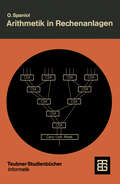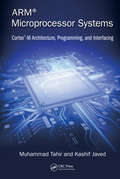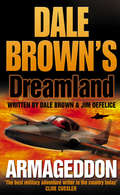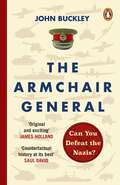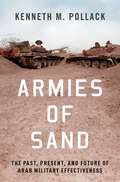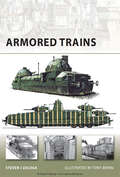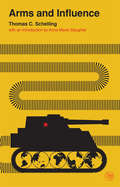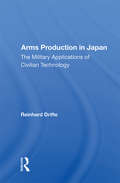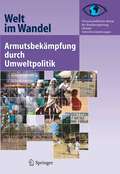- Table View
- List View
Arithmetik in Rechenanlagen: Logik und Entwurf (Leitfäden der angewandten Mathematik und Mechanik)
by Otto SpaniolARM Assembly Language: Fundamentals and Techniques
by William HohlWritten by the director of ARM's worldwide academic program, this volume gives computer science professionals and students an edge, regardless of their preferred coding language. For those with some basic background in digital logic and high-level programming, the book examines code relevant to hardware and peripherals found on today's microco
ARM Assembly Language with Hardware Experiments
by Ata Elahi Trevor ArjeskiThis book provides a hands-on approach to learning ARM assembly language with the use of a TI microcontroller. The book starts with an introduction to computer architecture and then discusses number systems and digital logic. The text covers ARM Assembly Language, ARM Cortex Architecture and its components, and Hardware Experiments using TILM3S1968. Written for those interested in learning embedded programming using an ARM Microcontroller.
ARM Microprocessor Systems: Cortex-M Architecture, Programming, and Interfacing
by Muhammad Tahir Kashif JavedThis book presents the use of a microprocessor-based digital system in our daily life. Its bottom-up approach ensures that all the basic building blocks are covered before the development of a real-life system. The ultimate goal of the book is to equip students with all the fundamental building blocks as well as their integration, allowing them to implement the applications they have dreamed up with minimum effort.
ARM Microprocessor Systems: Cortex-M Architecture, Programming, and Interfacing
by Muhammad Tahir Kashif JavedThis book presents the use of a microprocessor-based digital system in our daily life. Its bottom-up approach ensures that all the basic building blocks are covered before the development of a real-life system. The ultimate goal of the book is to equip students with all the fundamental building blocks as well as their integration, allowing them to implement the applications they have dreamed up with minimum effort.
Armageddon (Dale Brown’s Dreamland #6)
by Dale Brown Jim DeFeliceThe sixth in the series of high-tech thrillers centred on Dreamland – a top-secret USAF weapons research centre – from the acclaimed author of Flight of the Old Dog and Air Battle Force.
The Armchair General: Can You Defeat the Nazis? (The Armchair General #1)
by John Buckley***AVAILABLE FOR PRE-ORDER NOW***A ground-breaking approach to history where YOU choose the fate of WWII - perfect for readers of Bletchley Park Brainteasers and The GCHQ Puzzle Book.____________________________________________________________________________TAKE THE HOTSEATAssume the role of real Generals, Leaders, Soldiers and Intelligence Officers in the Allied Forces during WWII, including Winston Churchill and President Eisenhower.EXAMINE THE INTELLIGENCEExplore eight key moments of the war with real contemporaneous intelligence: Britain's Darkest Hour, 1940; The War in North Africa; Stalin's War on the Eastern Front; The Pacific Battle of Midway; The Dresden Bomber Offensive; Casablanca; Arnhem and Operation Market Garden; The Bomb and Hiroshima.CONSIDER THE SCENARIO & MAKE YOUR DECISIONFrom battlefields to war cabinets, each tactical and strategic decision you make leads to a different outcome.Will you follow the path of the past - or shape a new history?________________________'An original and exciting approach . . . Buckley is one of our very finest historians. The Armchair General adds enormously to our understanding of the conflicts.' JAMES HOLLAND'A reminder that history is a never ending now, a relentless and endless present that comes without the luxury of hindsight.' AL MURRAY, comedian and writer
Armies of Sand: The Past, Present, and Future of Arab Military Effectiveness
by Kenneth M. PollackSince the Second World War, Arab armed forces have consistently punched below their weight. They have lost many wars that by all rights they should have won, and in their best performances only ever achieved quite modest accomplishments. Over time, soldiers, scholars, and military experts have offered various explanations for this pattern. Reliance on Soviet military methods, the poor civil-military relations of the Arab world, the underdevelopment of the Arab states, and patterns of behavior derived from the wider Arab culture, have all been suggested as the ultimate source of Arab military difficulties. In Armies of Sand, Kenneth M. Pollack assesses these differing explanations and isolates the most important causes. Over the course of the book, he examines the combat performance of fifteen Arab armies and air forces in virtually every Middle Eastern war, from the Jordanians and Syrians in 1948 to Hizballah in 2006 and the Iraqis and ISIS in 2014-2017. The book ultimately concludes that reliance on Soviet doctrine was more of a help than a hindrance to the Arabs. In contrast, politicization and underdevelopment were both important factors limiting Arab military effectiveness, but patterns of behavior derived from the dominant Arab culture was the most important factor of all. Pollack closes with a discussion of the rapid changes occurring across the Arab world, and suggests that because both Arab society and warfare are changing, the problems that have bedeviled Arab armed forces in the past could dissipate or even vanish in the future, with potentially dramatic consequences for the Middle East military balance. Sweeping in its coverage, this will be the go-to reference for anyone interested in the history of warfare in the Middle East since 1945.
Armies of Sand: The Past, Present, and Future of Arab Military Effectiveness
by Kenneth M. PollackSince the Second World War, Arab armed forces have consistently punched below their weight. They have lost many wars that by all rights they should have won, and in their best performances only ever achieved quite modest accomplishments. Over time, soldiers, scholars, and military experts have offered various explanations for this pattern. Reliance on Soviet military methods, the poor civil-military relations of the Arab world, the underdevelopment of the Arab states, and patterns of behavior derived from the wider Arab culture, have all been suggested as the ultimate source of Arab military difficulties. In Armies of Sand, Kenneth M. Pollack assesses these differing explanations and isolates the most important causes. Over the course of the book, he examines the combat performance of fifteen Arab armies and air forces in virtually every Middle Eastern war, from the Jordanians and Syrians in 1948 to Hizballah in 2006 and the Iraqis and ISIS in 2014-2017. The book ultimately concludes that reliance on Soviet doctrine was more of a help than a hindrance to the Arabs. In contrast, politicization and underdevelopment were both important factors limiting Arab military effectiveness, but patterns of behavior derived from the dominant Arab culture was the most important factor of all. Pollack closes with a discussion of the rapid changes occurring across the Arab world, and suggests that because both Arab society and warfare are changing, the problems that have bedeviled Arab armed forces in the past could dissipate or even vanish in the future, with potentially dramatic consequences for the Middle East military balance. Sweeping in its coverage, this will be the go-to reference for anyone interested in the history of warfare in the Middle East since 1945.
Armored Trains (New Vanguard #140)
by Steven J. Zaloga Tony BryanFirst seen during the American Civil War and later appearing in the Franco-Prussian War and the Anglo-Boer Wars, the armored train came to prominence on the Eastern Front during World War I. It was also deployed during the Russian Civil War and the technology traveled east into the Chinese Civil War, and the subsequent war with Japan. It saw service on the Russian Front in World War II, but was increasingly sidelined because of its vulnerability to air attack. Steven J Zaloga examines the origins and development of the armored train, focusing equally on the technical detail and on the fascinating story of how armored trains were actually used in combat. This title will appeal to armor, military history and railroad enthusiasts alike.
Armorial Porcelain: The Genesis
by Howell G. Edwards Rachel L. Denyer Morgan C.T. DenyerThis book explores the genesis of armorial porcelain manufacture in Britain. While heraldic devices began appearing on Chinese porcelain from the sixteenth century onwards, armorials did not appear on British porcelain until the 1750s. It examines the development of porcelain in China and traces its introduction to Western Europe. The book delves into the market for armorial porcelains, from the early commissioning of Chinese armorial porcelainware to the establishment of manufactories in England capable of producing armorial porcelain. It also discusses the reasons behind the timing of armorial porcelain's manufacture in Britain. Additionally, it assesses armorial porcelain as a contemporary historical source. Building upon previous research by the authors, the book presents armorial porcelain as a distinct and highly personalized product. By integrating detailed genealogical research, cultural insights, and chemical analysis, it offers a comprehensive understanding of armorial porcelain within the context of heritage, culture, and science.
Armour: Materials, Theory, and Design
by Paul J. HazellHighlights Recent Advances in Materials/Armour TechnologyAs long as conflict exists in the world, protection technologies will always be in demand. Armour: Materials, Theory, and Design describes the existing and emerging protection technologies that are currently driving the latest advances in armour systems. This book explains the theory, applica
Armour: Materials, Theory, and Design
by Paul J. HazellUpdated throughout for the new edition, Armour: Materials, Theory, and Design covers extant and emergent protection technologies driving advances in armour systems. Covering materials, theory and design, the book has applications in vehicle, ship, personnel and building use.Introducing a wide range of armour technologies, the book is a key guide to the technology used to protect against both blasts and ballistic attacks. Chapters cover bullets, blasts, jets and fragments, as well as penetration mechanics. The new edition builds on the previous one, discussing ceramics and metallic materials as well as woven fabrics and composite laminates. Detailing modern technology advancements, the second edition has also been expanded to include improved explanations on shock mechanisms and includes significantly more figures and diagrams.An essential guide to armour technology, this book outlines key ways to implement protective strategies applicable for many types of conflict.
Armour: Materials, Theory, and Design
by Paul J. HazellUpdated throughout for the new edition, Armour: Materials, Theory, and Design covers extant and emergent protection technologies driving advances in armour systems. Covering materials, theory and design, the book has applications in vehicle, ship, personnel and building use.Introducing a wide range of armour technologies, the book is a key guide to the technology used to protect against both blasts and ballistic attacks. Chapters cover bullets, blasts, jets and fragments, as well as penetration mechanics. The new edition builds on the previous one, discussing ceramics and metallic materials as well as woven fabrics and composite laminates. Detailing modern technology advancements, the second edition has also been expanded to include improved explanations on shock mechanisms and includes significantly more figures and diagrams.An essential guide to armour technology, this book outlines key ways to implement protective strategies applicable for many types of conflict.
Arms and Influence (Veritas Paperbacks)
by Thomas C. Schelling"This is a brilliant and hardheaded book. It will frighten those who prefer not to dwell on the unthinkable and infuriate those who have taken refuge in stereotypes and moral attitudinizing."—Gordon A. Craig, New York Times Book Review Originally published more than fifty years ago, this landmark book explores the ways in which military capabilities—real or imagined—are used, skillfully or clumsily, as bargaining power. Anne-Marie Slaughter’s new introduction to the work shows how Schelling’s framework—conceived of in a time of superpowers and mutually assured destruction—still applies to our multipolar world, where wars are fought as much online as on the ground.
Arms Control and Disarmament: 50 Years of Experience in Nuclear Education
by Paolo Foradori Giampiero Giacomello Alessandro PascoliniThis volume is a collection of contributions by world-leading experts in the nuclear field who participated in the educational activities of the International School on Disarmament and Research on Conflicts (ISODARCO). It features some of most prominent scholars and practitioners who contributed in fundamental ways to shaping policies, strategies, theories, scholarly studies, and debates in the field of non-proliferation and disarmament. On the occasion of ISODARCO's 50th anniversary this book revisits a selection of contributions that capture the pressing issues during the five decades of continuous engagement in disarmament and non-proliferation education.
Arms Control and Disarmament: 50 Years of Experience in Nuclear Education
by Paolo Foradori Giampiero Giacomello Alessandro PascoliniThis volume is a collection of contributions by world-leading experts in the nuclear field who participated in the educational activities of the International School on Disarmament and Research on Conflicts (ISODARCO). It features some of most prominent scholars and practitioners who contributed in fundamental ways to shaping policies, strategies, theories, scholarly studies, and debates in the field of non-proliferation and disarmament. On the occasion of ISODARCO's 50th anniversary this book revisits a selection of contributions that capture the pressing issues during the five decades of continuous engagement in disarmament and non-proliferation education.
Arms Production In Japan: The Military Applications Of Civilian Technology
by Reinhard DrifteAlthough Japan's arms industry is still relatively small, significant political, economic, and technological developments indicate its growing importance and pave the way for Japan's increasing involvement in arms production. In this comprehensive study, Dr. Drifte examines both the domestic and international environments that are encouraging Japan
Arms Production In Japan: The Military Applications Of Civilian Technology
by Reinhard DrifteAlthough Japan's arms industry is still relatively small, significant political, economic, and technological developments indicate its growing importance and pave the way for Japan's increasing involvement in arms production. In this comprehensive study, Dr. Drifte examines both the domestic and international environments that are encouraging Japan
Arms Transfers to Israel: The Strategic Logic Behind American Military Assistance
by David RodmanThis book dispels two common myths about the American-Israeli patron-client relationship -- that arms transfers to Israel have been motivated by American domestic politics rather than national interests and that these arms transfers have come without any political strings attached to them. The first part of the book describes and analyses the institutionalisation of the American-Israeli arms pipeline during the Johnson administration, demonstrating conclusively in the process that arms transfers to the Jewish state were based primarily on American national interests. The second part of the book consists of four case studies that clearly reveal that American arms transfers to Israel, whether in wartime or in peacetime, have always come with a diplomatic price tag attached to them. The book is based largely on American government documents from the Foreign Relations of the United States (FRUS) series, from the Lyndon B Johnson Presidential Library, and from the United States National Archives.
Army Ants: Nature's Ultimate Social Hunters
by Daniel J. KronauerA richly illustrated, captivating study of army ants, nature’s preeminent social hunters.A swarm raid is one of nature’s great spectacles. In tropical rainforests around the world, army ants march in groups by the thousands to overwhelm large solitary invertebrates, along with nests of termites, wasps, and other ants. They kill and dismember their prey and carry it back to their nest, where their hungry brood devours it. They are the ultimate social hunters, demonstrating the most fascinating collective behavior.In Army Ants we see how these insects play a crucial role in promoting and sustaining the biodiversity of tropical ecosystems. The ants help keep prey communities in check while also providing nutrition for other animals. Many species depend on army ants for survival, including a multitude of social parasites, swarm-following birds, and flies. And while their hunting behavior, and the rules that govern it, are clearly impressive, army ants display collective behavior in other ways that are no less dazzling. They build living nests, called bivouacs, using their bodies to protect the queen and larvae. The ants can even construct bridges over open space or obstacles by linking to one another using their feet. These incredible feats happen without central coordination. They are the result of local interactions—self-organization that benefits the society at large.Through observations, stories, and stunning images, Daniel Kronauer brings these fascinating creatures to life. Army ants may be small, but their collective intelligence and impact on their environment are anything but.
Aroma and Flavor in Product Development: Characterization, Perception, and Application
by Rajnibhas Sukeaw SamakradhamrongthaiOne of the greatest challenges facing food product developers today is that of preserving aroma and flavor stability over time without comprising quality. With Aroma and Flavor in Product Development: Characterization, Perception, and Application, researchers and product innovators will find a thorough elucidation of the dynamic interplay of aroma and flavor in complex formulations across various applications, and of the crucial role of foundational elements in crafting globally appealing products. This guide provides essential insights into perception, formation, and development, enabling developers to enhance food items' organoleptic qualities and thereby provide consumers with an enhanced sensory experience. It is unique in its focus on raw material properties, processing changes, and flavor application tools, offering comprehensive coverage of encapsulation methods, isolation, extraction, and release mechanisms. Employing tools such as gas chromatography and descriptive sensory analysis, the text decodes complex chemical compositions to enable effective communication and replication of desired sensory experiences. Readers will finish this text not only with a strong grasp on the latest insights into aroma and flavor research trends, such as sustainable sourcing and novel extraction methods, but also with a vision for the future of food product development.
Aroma Biotechnology
by Ralf G. BergerAroma biotechnology opens access to natural volatile flavors. Due to the attribute of "naturalness" these aromas are the most valuable ingredients for foods, cosmetics and related products. The author describes biocatalyzed reactions and biogenetic routes leading to aroma and flavor compounds and he depicts in detail their utilisation in industrial scale processes. All the important topics, including de-novo-synthesis, genetic engineering, in vitro rDNA methods, laboratory requirements and techniques, upscaling, product recovery, profitability, and legal aspects are covered. R.G. Berger contributes his own experimental experience to all except one chapter and leads the reader into state-of-the-art aroma biotechnology.
Aromatic Plants: Basic and Applied Aspects (World Crops: Production, Utilization and Description #7)
by A. Koedam M. S. Margaris D. VokouThe use of aromatic plants has been practised since ancient times as is evidenced by records of Chinese, Egyptian, Mesopotamian, Greek and Roman origin; recent findings in Pakistan prove that it goes as far back as 5000 years. Accordingly, the importance and value ascribed to them were always high. Either as a medicine, a foodstuff, a seasoning, a cosmetic or an element of religious rituals the aromatic plant was indispensable. It is not to be forgotten that desire tor the riches of India - spices among which - and the struggle to monopolize the trade of the latter con tributed to the opening of new sea routes, discovering of continents and altering the picture of the known world. With the advent of modern civilization, characterized by scientific and technological development which dIverted estimation and consumption towards artificial products, aromatic plants experienced a temporary de cline of use retaining, however, theIr importance In sectors such as the culinary art and cosmetics industry.
